By Sujeet Rajan

Included in seamless tandem are also small one-man offices in high-rises fronted by locked double door vestibules with high-end scanners and cameras for enhanced scrutiny and security, and mini factories and tiny workshops where skilled workers cut, cast, solder and set stones worth millions of dollars.
Imagine a combination of high-rise vertical car park chockful of vehicles, and a vast, gargantuan grocery store crammed horizontally with endless neat rows of products. Now imagine those vertical and horizontal rows filled with diamonds and jewelry. You might get the virtual picture of what 47th Street wedged between 5th and 6th Avenue, close to the Rockefeller Center, Radio City Hall, Madison Square Garden and Times Square, looks like.
That one teeming block is touted as the world’s largest shopping district for all diamonds and high-end jewelry. There is no real data for the volume of business in the district, but past reports and vendors and businessmen interviewed by India Overseas Report reckoned it ranges from $30-$40 million daily. There are several other prominent diamond districts in the world, including the Bharat Diamond Bourse in Mumbai, which is spread over a 20-acre plot.
Some 33,000 people work in the 3,500 cutting, polishing and sales businesses lining the block, reported Jewish Telegraphic Agency after the release of the Adam Sandler hit film ‘Uncut Gems’, set in the Diamond District. Fans of the late Indian actor Irrfan Khan may remember a scene of his with Natalie Portman from the 2009 film ‘New York I Love You’ which featured the Diamond Exchange in the district.
The Diamond District was created in the 1920s after jewelers and workers were forced to leave their hub near what is now the Wall Street and Canal Street areas, due to rising rent for leased properties. According to Wikipedia, the district grew in importance when Nazi Germany invaded the Netherlands and Belgium, forcing thousands of Orthodox Jews in the diamond business to flee Amsterdam and Antwerp and settle in New York City. Most of them remained after World War II and continue to be a dominant influence in the Diamond District.
In time, Armenian and Indian immigrants emigrated also to start successful businesses in the diamond industry. Though there is no official data on the number of Indian immigrants working in the Diamond District, on any given day, one can find a large number of Indians in the area, especially those of Gujarati-origin. Most of them are not tourists, but work in the area. Russian immigrants dominate too, in the district.
It may come as a shock to some that the more iconic names associated with the jewelry business in New York City, like Tiffany and Co., De Beers, Harry Winston, Cartier, Mikimoto, Van Cleef & Arpels, Graff, Leviev and Kwiat, among others, are located elsewhere on 5th Avenue and Madison. The latter was the location where the fugitive diamantaire Nirav Modi started his eponymous store, at the launch of which he had exhibited a Maharani diamond necklace and earrings set worth $1.65 million. Celebrities like Naomi Watts and Lisa Haydon were in attendance.
During the rigors of the Covid lockdown, all business in the district came to a standstill for several months. Some businesses went kaput. For most who survived, however, there was a subsequent windfall as people flush with surplus money from pandemic relief funds rushed in hordes to indulge and invest, said several business owners in interviews to India Overseas Report.
However, interviews with several traders, vendors and store owners in the Diamond District and the Jackson Heights area in Queens, NY, where at least 16 big gold jewelry stores are located on one street – Kalpana Chawla Way – also indicated there is growing trepidation that a recession later this year, and political uncertainty over the Presidential elections next year, could deal another big blow financially to businesses located in New York City. Industry analysts, however, reckon growth is on the upswing for many more years to come, propelled also by male celebrities – especially in the music business, taking to wearing diamond jewelry accessories.
Kamlesh Shah, owner of Select Diam Inc. in the Diamond District, started his wholesale business in polished diamonds on the block in 1986. He proclaims himself to be a pioneer among Indians in the industry. He has weathered the lockdown of the pandemic without too much loss.
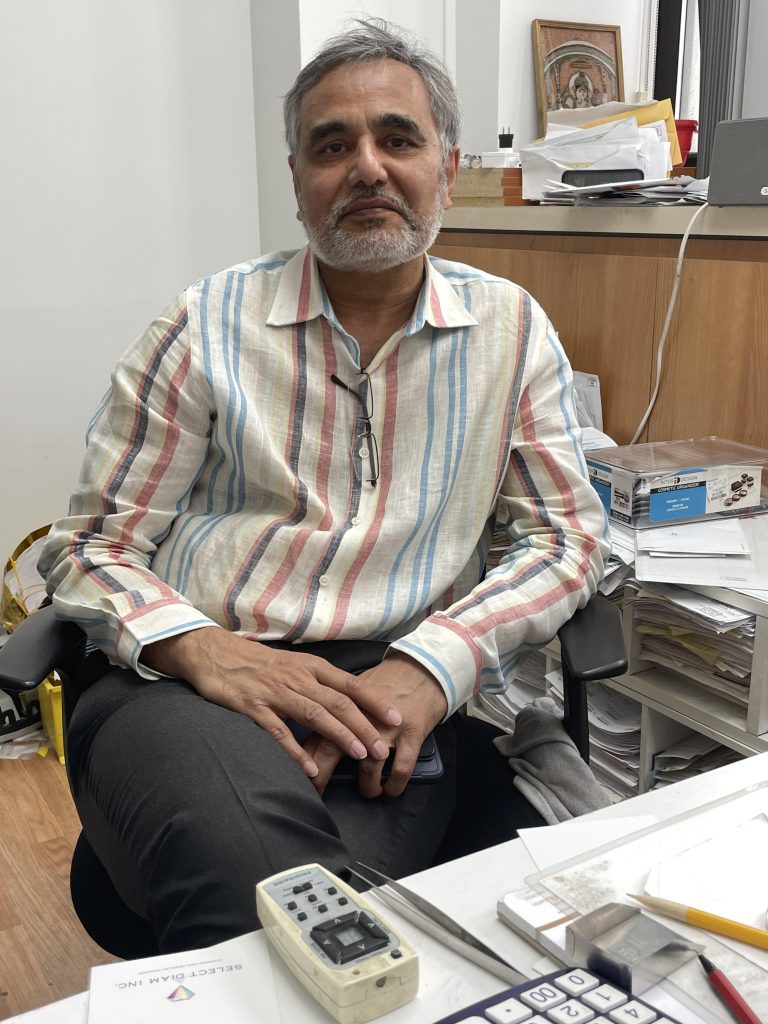
“In 2019 business was excellent, and till March of 2020 it was fine until the pandemic lockdown started. We were closed for 2 to 3 months. Business started to pick up slowly. In 2021, the business was mountain high. The entire 2021 was fantastic,” Shah revealed in an interview, sitting in his office with miniature idols of Ganesha stacked on one side.
“There were so many factors why business jumped in 2021. People were getting free money and sitting at home, saving on lots of expenses like traveling. While business was down in 2020 by around 50%, it was more than compensated by the boom in 2021 that sustained till June 2022. Since then, business has stagnated a bit and now it’s slowing down quite a bit, and there is decline because of talk of recession and political trouble,” Shah said, refusing to divulge in dollar terms his profit or losses.
Shah worked in India in the 1970s, manufacturing rough diamonds. His business expansion took him to Belgium and Israel for purchases and in 1995 he emigrated to the US. Now, he also creates unique jewelry for select clients. He has offices in Mumbai and exports smaller size diamonds from Gujarat.
“I’m working B2B as a vendor. I don’t want to discuss the volume and business in too much of detail, but a lot of my products are what clients showcase in large diamond stores,” Shah said. “For some customers a $100,000 diamond necklace is nothing. For some a $1 million diamond ring is what they seek.”
He added: “When the pandemic started, there was panic in the industry. We all wondered why people will buy diamonds, but it went the other way. People were saving, then they started buying. It was as if somebody dreamed of buying a Ferrari, and then they went out and bought that Ferrari.”
Shah says a lot of Americans and Indians too, now, buy diamonds as an investment.
“Gold they just put into the locker. A diamond necklace one can enjoy wearing, and the investment grows too,” he said.
Asked if diamonds were a good choice to wear on the streets of New York City, he said it had become popular especially with rappers adorning themselves. “Over here, you see rappers wear it everywhere. It’s not risky.”
Shailesh Shah (not related to Kamlesh Shah), co-owner along with his wife Meena Shah, of Aryesha Inc., a wholesaler diamond business located in the Diamond District, reiterated Kamlesh’s words about the enormous growth in his business in 2021, after the temporary loss when Covid forced the industry to come a standstill.
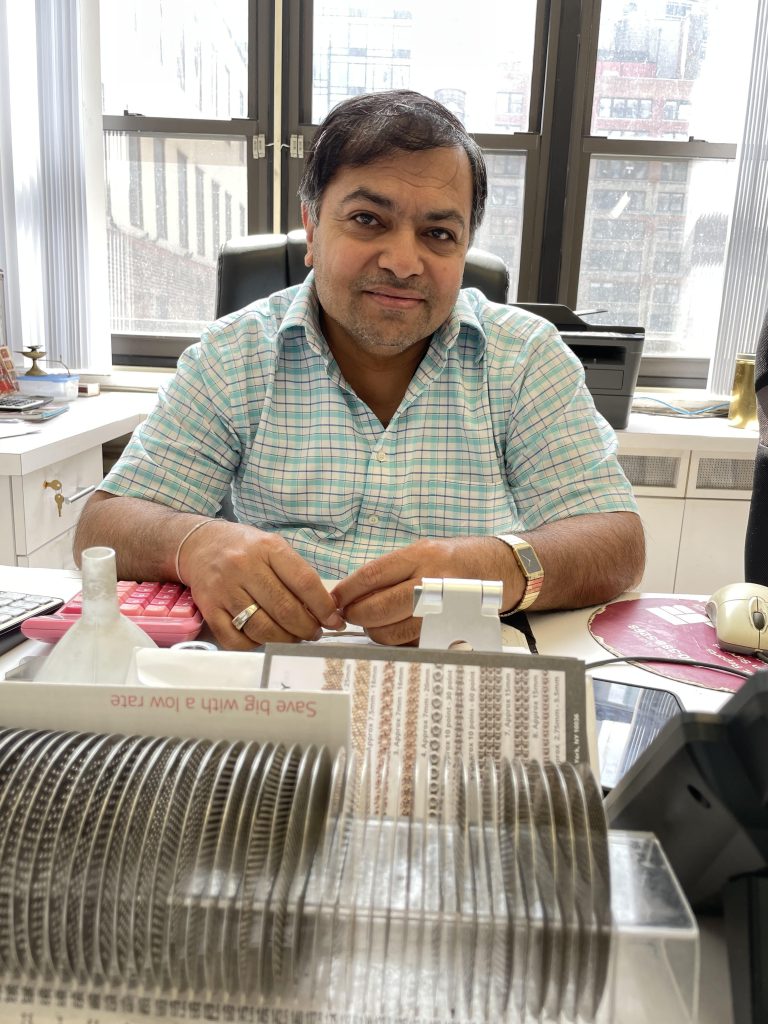
“Diamonds people buy for jewelry purpose only. It is for investment only if you buy a big size carat diamond like a $10K or more diamond. It can appreciate by 20 to 30% pretty soon,” he said in an interview in his office, located in a high rise on the block. His business encompasses purchasing and selling diamonds in several other countries, including China and Japan.
“I also buy closeout diamonds from here and supply that in India. The mixed diamonds count as scrap diamonds, but diamonds are forever. So, we can reuse the diamond, repolish it sometimes and sell for a profit,” he revealed.
“Before the pandemic business was not great. It was a slow-moving market but after that it went to dizzy heights as a lot of people started to buy jewelry, because how much can they buy clothes and grocery. They got a lot of money from the government, and they started using that to buy diamonds. Businesses picked up by July of 2020 and then six months later it became very good. It was more than double, triple than 2019,” Shailesh said.
“The year 2022 was also great till October and then it started to slow down and now it’s gotten even slower. People have run out of money and the government wants to bring a recession purposely to curb inflation. People are scared to buy diamonds which is a luxury item,” he opined. “When a recession comes this is the first industry that gets affected. Gold is going a different way as it is also used for jewelry, but it’s connected with war like stocks and bond markets, so it has higher appreciation during such times.”
Shailesh said that in 2019 he turned in around $2 to $3 million, while in 2021, it became $7 to $8 million in sales, and he expanded his business.
“The government gave loans to sustain the industry. We bought more diamonds and sold more diamonds,” he explained.
Shah has seen a lot of fluctuation in the industry in his more than three decades of being in business and says he can manage another crisis.
“Basically for 35 years I have seen ups and downs, but overall, we are used to control and manage during the times when it changes,” he said, forecasting that by the end of this year, his business might take a 35 to 40 percent hit from a likely recession and slowdown in demand. “Banks have their hands tied to lend money and interest rates are high too. It seems a tough situation.”
Shah said he has two daughters who are not interested in joining his business. His older daughter is in medical school; the younger one works with Morgan Stanley.
“Nobody from my family wants to come into this business. So, for me, this business is a very uncertain business. Today you have a $100K business, tomorrow it could be $10K business. But one thing I’ve learnt is at the end of most years, it evens out, and business stays in range,” he said with a shrug of his shoulders.
He says the US government should do more to protect and nurture the diamond industry.
“Here in the US, it’s not easy to learn how to polish diamonds. To learn the trade, you have to work with a trader. If the government can put more duty on import jewelry, then jewelry can be made here so more people can get work. Right now, it is just postman work. They get jewelry from India, China, Japan or elsewhere, and deliver it to clients,” he said.
“A big challenge for the industry is people are running out of money. It was good the government gave money to people. Trump handled it very well because if you don’t lend money, robberies will happen and millions of people can die. It benefited the economy and people survived. There is a problem of inflation but that can be controlled,” Shah said.
DIAMOND INDUSTRY IS GROWING
According to statista.com, in 2022, the retail sales of jewelry in the United States were estimated to amount to approximately $91.5 billion. This was a $5 billion dollar increase on the previous year. Until 2021, sales had remained consistently around the $60 billion mark.
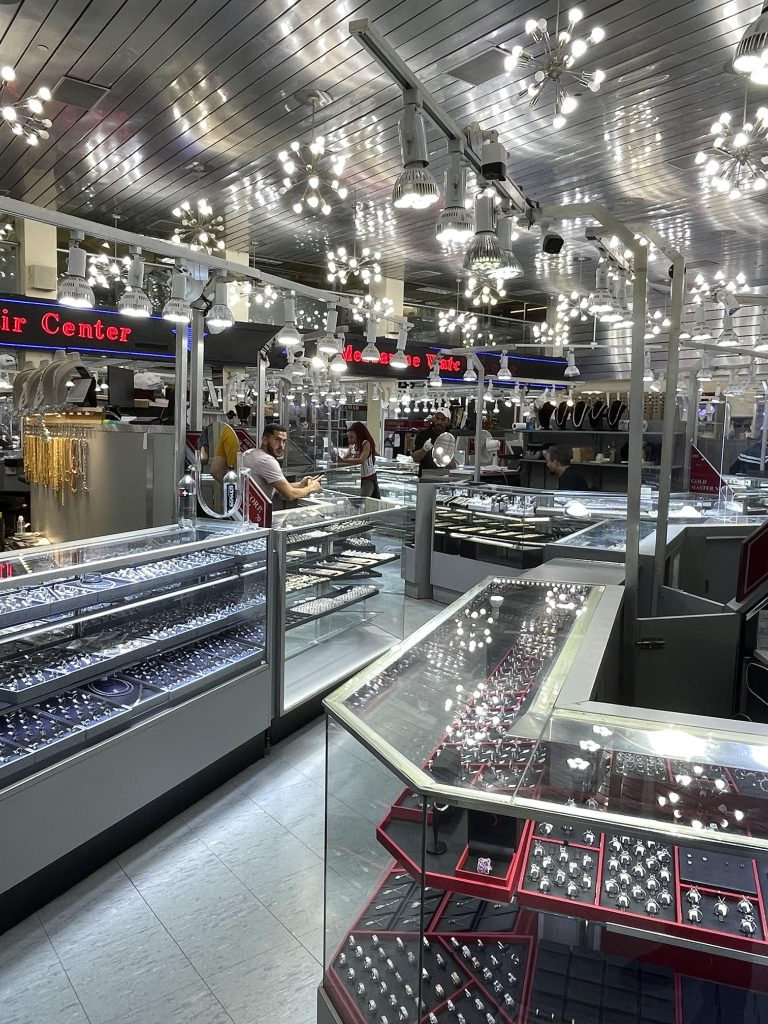
The US jewelry market earned $57.965 billion in annual revenue in 2021, according to industry expert Wesley Bustamante. The global jewelry industry is valued at $249.02 billion as of 2021. The US jewelry market is expected to grow by a CAGR of 1.31% from 2021 to 2026 and earn $61.868 billion in revenue by 2026, said Bustamante, in a press release. Online jewelry sales amounted to almost $7.6 billion in 2021 in the US, he reckoned. As of 2021, there are 51,153 jewelry store businesses in the US. California has the highest number with 2,614, New York with 2,170, and Florida with 1,881.
Vendors like Shailesh Shah and Kamlesh Shah sit in small offices where long-term tenants pay around $2,000 to $3000 a month for a lease. It escalates sharply for those who want to secure a new office lease. A security guard at one of the buildings informed me that it was hard to keep up with the flow of tenants given the high number of rotations since leases often change hands, plus the sheer number of people who visit daily.
Many businesses closed down in the district especially during the pandemic; but new tenants filled the space quickly. In most buildings some name plates of businesses at the reception don’t match what’s hung on doors on floors.
Although I was cautious not to carry a bag on me as that is viewed suspiciously by businesses in the district, on more than a dozen instances, as I scoured for interviews, I was blocked from gaining entry into offices – businesses either refused me entry, or preferred to talk through closed doors, or in the vestibule area, which feels like being trapped in an elevator with two doors and a voice booming through a speaker, as a camera scans and sizes you up, as much for hidden weapons as for nefarious intentions.
Most independent jewelry shops have locks on their doors; they get to scrutinize customers, before deciding to let them in or not. At jewelry exchanges there are multiple number of guards in plain clothes who are positioned strategically in corridors, and at entrance points.
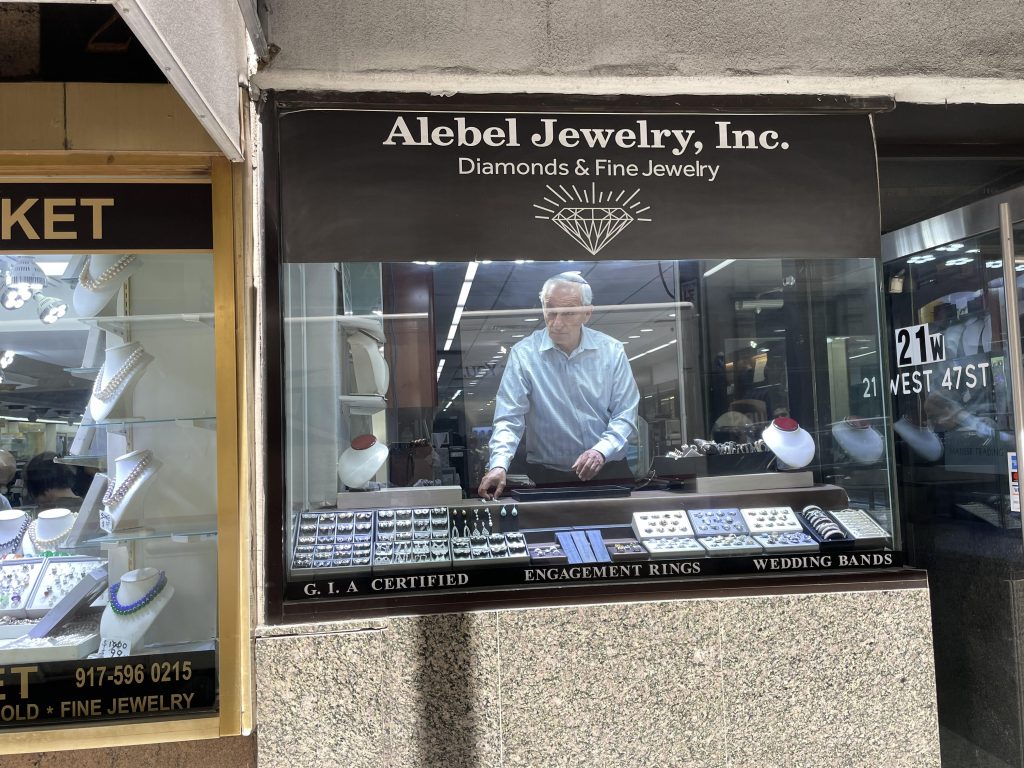
While pedestrians and shoppers are often cajoled and persuaded by loquacious salespersons on the street to try walking into one of the exchanges or shops on the street, the unwritten mantra in the district is that strangers who don’t want to shop are not welcome to enter premises or linger around.
Some businessmen informed me that they were wary of everybody who knocked at their door; feared personal safety.
“For years I used to be as discreet as possible when I exited the building after work. I used to take public transportation from different subways to get home. I feared being followed back home by miscreants,” one vendor disclosed, requesting anonymity. He still takes precautions when exiting the building, on certain days, he added. Most vendors in the district try and dress down, so as not to draw attention to themselves.
Another vendor said that despite a high volume of security in the district, which makes some feel they are working at Fort Knox – private guards and NYPD personnel make it one of the most heavily guarded streets in all of Manhattan – there is wariness and a sense of trepidation every day they go to work.
Earlier this week, a man changing a tire near the Diamond District was robbed of $100,000 in gems by a trio of thieves, who took off in a taxi. The incident was reported in Daily Mail.
Last year, in November, gun-toting crooks robbed three Diamond District customers of $72,000 in jewelry, reported the New York Post. One of the customers made it amply clear that the perpetrators knew whom to target, as she was approached as soon as she stepped out from a store after a purchase.
An NYPD officer with the Counterterrorism Bureau, patrolling the district, informed me that private security guards were far more in numbers than NYPD personnel in the district. It was one of the safest streets in the city, if not the safest, he said.
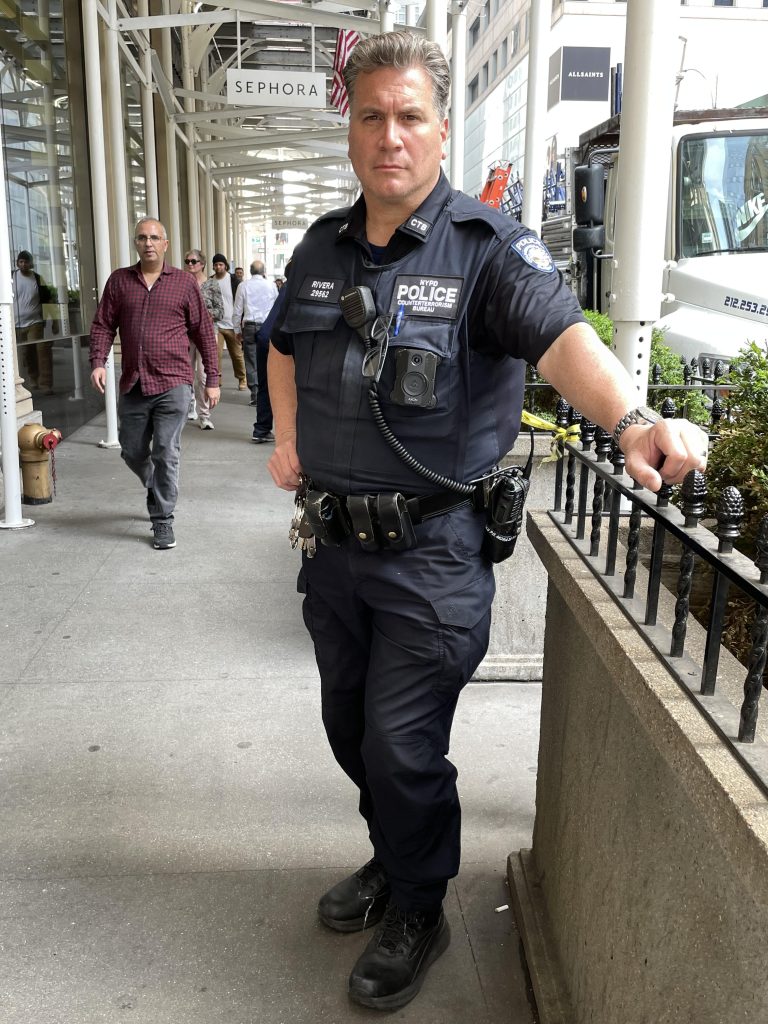
“This is a very, very secure zone,” he said.
Rami Borochov, owner of the prominent R & R Jewelers that has been on the block for 30 years, deals with diamonds and fine jewelry. He is optimistic that business “will be good as long as there’s love and affection out there, business will continue.”
He reasoned: “They might consider their budget and everything, but they will still buy.
“Because of the closure during Covid there was zero business for three months. Some areas of the industry after the pandemic did well; the hip hop jewelry took off. But regular average jewelers did ok, not crazy business,” Borochov said.
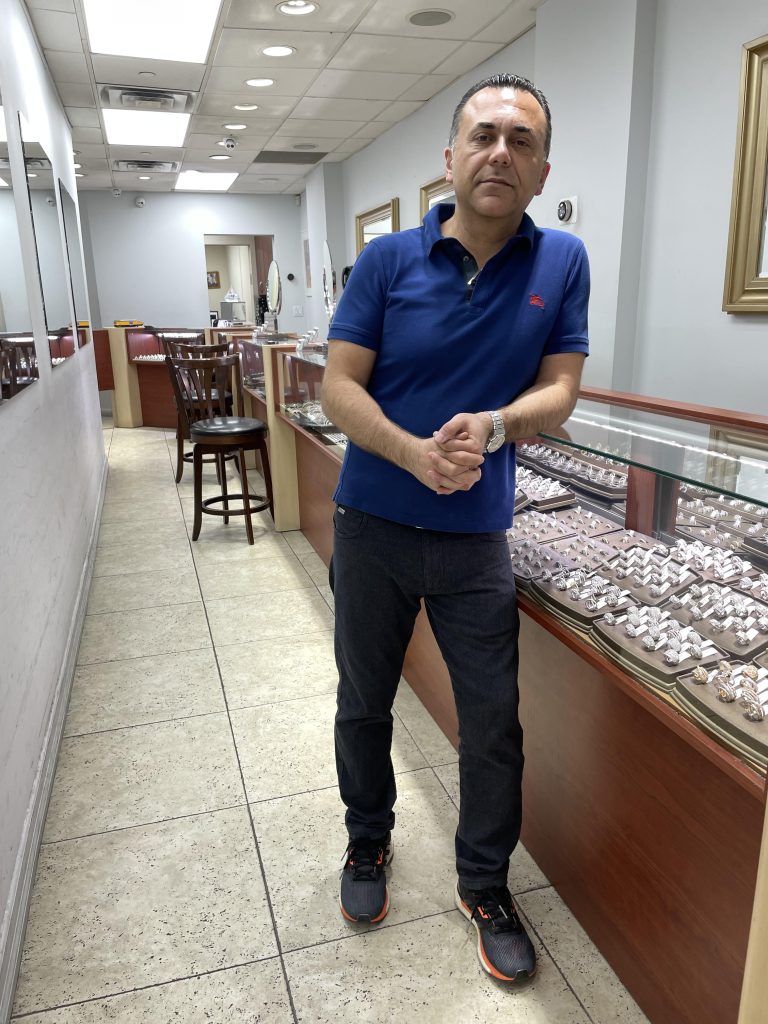
“The secret in our industry is that the more inventory you have the more chance you have to sell. If you don’t have selection, then the client will go to where there is selection. Cutting back inventory, you will hurt yourself,” he said, when queried on how he plans to deal with a tight market situation later this year, if it were to happen.
Also optimistic about the business staying in good shape is Jay Donda, Partner and Managing Director of Rainbow Gems New York LLC, located in the Diamond District. He said in an interview to India Overseas Report that his family-owned business was the largest manufacturer in the world of fancy color diamonds, the most expensive and rare type of diamonds that are mined.
Donda emigrated from India to the US to study entrepreneurship at Pace University and graduated in 2019, before he joined the family business, which is headquartered in Hong Kong.
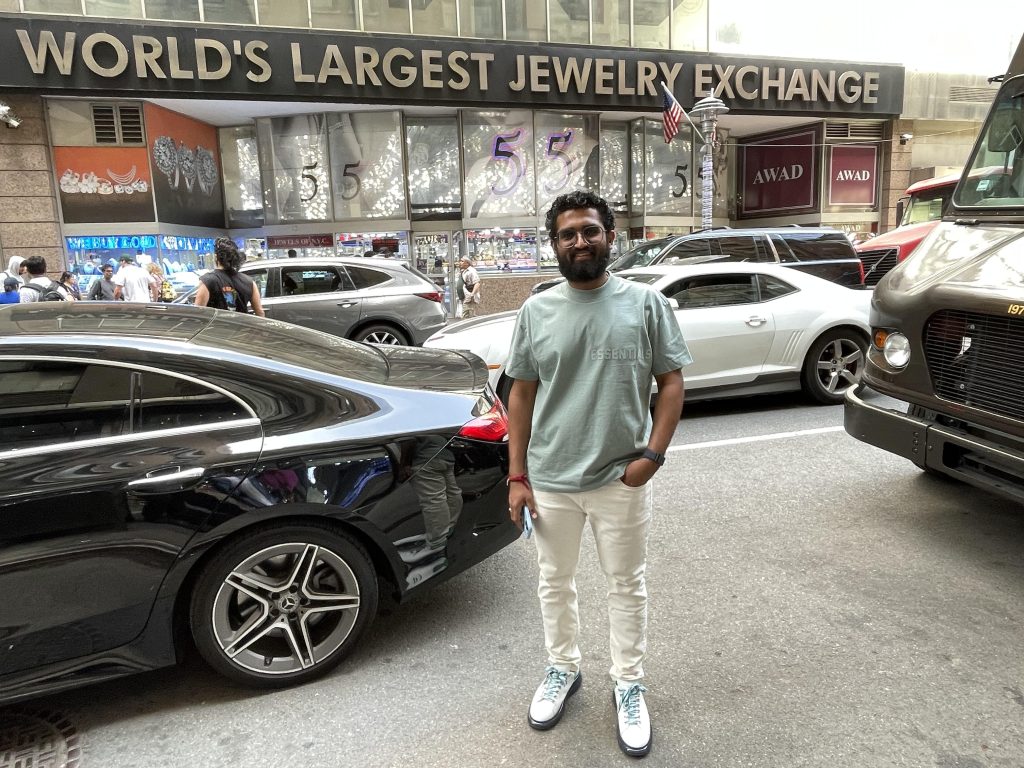
The business of diamonds is not easy to master, Donda said. The Gemological Institute of America, which has a location in the district to train gemologists, has developed a uniform list of 12 main colors, 90 secondary hues, 9 different intensity levels, and over 230 color combinations.
DIAMONDS OF ALL HUES
Diamonds are found with dominant colors of yellow, pink, green, champagne, gray, violet, blue, orange, chameleon, purple, fancy white and fancy black. The 9 different intensity grades are faint, very light, light, fancy light, fancy, fancy intense, fancy vivid, fancy deep and fancy dark.
Then there are also lab-created diamonds made using techniques known as Chemical Vapor Deposition (CVD) or High-Pressure Crystal Formation (HPHT). To create the diamonds, carbon atoms are extracted from high-pressure vapor in a chamber. This process creates diamond layer by layer over time typically three months, though it can take longer. Real diamonds, on the other hand, can take thousands of years to form, informed Donda.
“Depending on market conditions and customer demand, we do business of $100 to $150 million a year,” Donda said.
Talking of the Covid pandemic, Donda said “as soon as the world reopened everything was good.
“The year 2021 was really good and 2022 was good too, but it is going down now,” he said. “I think the pandemic taught people how to use their money wisely. So, they started to invest in gold, diamonds. These are luxury, valuable items that they can pass down the generations. And it cannot be used only by one generation. It’s a good investment to buy gold, diamonds and jewelry,” Donda reasoned.
“Right now, there is a dip as people have used up whatever money they had for investment. Only a very few percentages of people who had money before the pandemic are still buying,” he said.
“We sell pink diamonds. It had a 350% increase over 10 years which is more than gold. Gold went up in the same period by only 315%. Even in the last five years, pink diamonds are up in value as mine diamonds are harder and rarer to get. It is still going up. We are only dealing with the most expensive kind of diamond which only 1 percent of people can afford, and we are only catering to that market,” Donda said.
Talking of pink diamonds, “The Eternal Pink,” a 10.57-carat internally flawless vivid purplish-pink diamond will be offered at Sotheby’s New York in an auction on June 8, according to reports. Its estimate is $35 million, which if achieved, would make it one of the most valuable gems ever sold at auction.
“We don’t sell in India. India is an upcoming market though, I feel, in the next 10 years. We do jewelry shows and word of mouth with selective brands all around the globe,” Donda said, of his marketing strategy to grow business.
In Hong Kong, Donda’s family business has six to eight employees. In the Diamond District, there are a total of six employees, including himself.
Donda cautions young entrepreneurs getting into the trade, without adequate preparation.
“This is a business where you have to work very hard. Plus have a strong financial background, as it is not an industry where you buy today, and you can sell tomorrow. Sometimes we sell a diamond after keeping it for 10-15 years. It is hard work and the capacity to hold the diamonds for a longer period of time is critical for success,” he said.
Several vendors speaking on condition of anonymity informed that while real certified diamonds were what keeps the district going, the cheap and glittery lab-grown diamonds – which cost wise is at the lower, other end of the spectrum from the glamorous type of business run by Donda – has eroded the value of the industry. Today, a one-carat lab-grown diamond is approximately 20% cheaper than its natural counterpart.
The rush of online businesses to cater to lab-grown diamonds – which lack investment value, as well as dearth of quality craftsmen who are rapidly dwindling in the city, has forced work like polishing and cutting to be outsourced in bulk to countries in Asia, much like Apple phones. Surat in Gujarat, India, is known as the diamond polishing capital of the world. Nine out of ten of the world’s diamonds are polished in India. Many veteran in-house cutters in the Diamond District are employed by businesses with a niche clientele of celebrities who splurge on customized diamonds and unique accessories embedded with diamonds.
SECURITY AND CHALLENGES
A businessman on the block who has had considerable success in catering to a niche clientele of celebrities is Iranian immigrant Babak Ermankhah, who is famous for his Azad brand of watches. A former electrical engineer and an outstanding boxer who competed in other sports as well, Ermankhah has his own storefront which is adorned with photos of celebrities wearing his custom watches. Some of his watches are encrusted with a sizeable number of diamonds. A power tourbillion encrusted with white diamonds is priced at $29,300, while a 78 carat watch is $110,000.
Those Azad watch numbers pale in comparison, however, to what a watch fetched at a Christie’s auction held in Hong Kong in March of this year: a rare Patek Philippe ‘Sky Moon Tourbillon’ went under the hammer for an astounding $5.8 million, making it the most expensive watch ever sold in an online-only sale. If that’s impressive, consider the fact that Renani Jewels in India recently set a Guinness World Record for the most diamonds set on a watch. Weighing 373.30 grams, the wearable timepiece is set with a staggering 17,524 diamonds. It features 17,512 white diamonds and 12 black diamonds. The watch is named Srinkia, after an Indian goddess of wealth and good fortune.
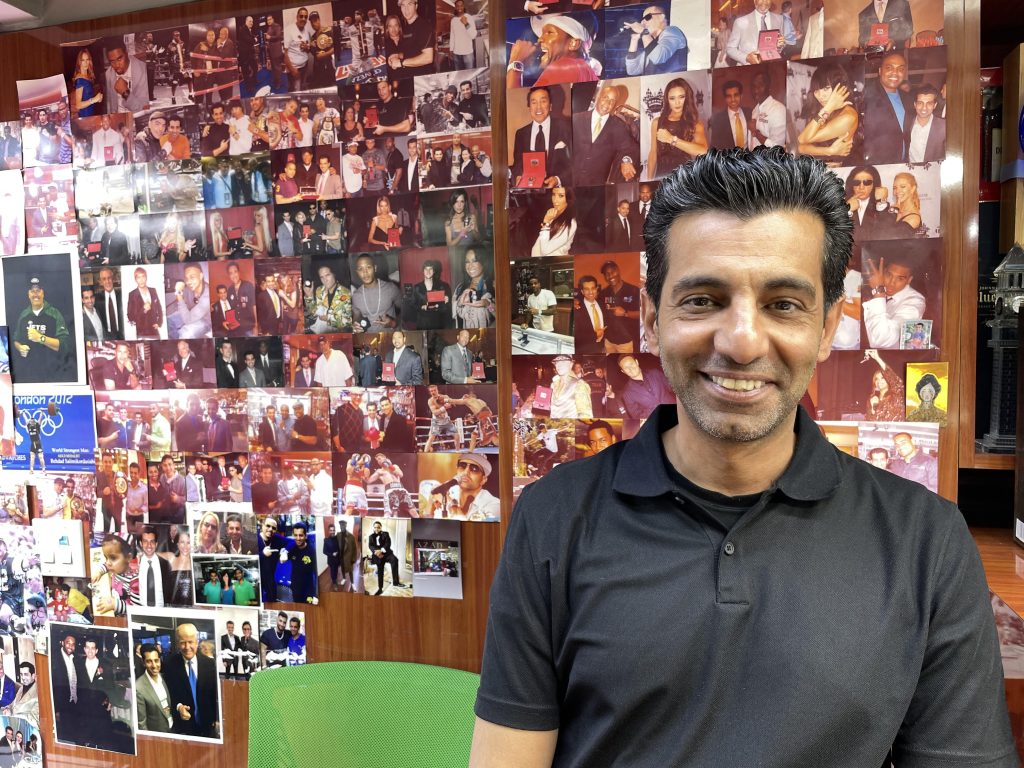
“I’ve been in this location for 24 years, since 1982,” Ermankhah said in an interview to India Overseas Report. “We are not back as yet,” he said of the devastating financial effect of the pandemic.
Celebrities from Donald Trump, Samuel L. Jackson, Marcus Allen, Matt Damon, Doctor J, 50 cent, Lil Wayne, Akon, Michael Strahan, Brandon Jacobs, and Josh Howard have sported his watches.
“We have a factory upstairs and I have seven to 13 people working, but until last month we were still closing at 3 p.m. I still don’t put anything in the window as I think this city is not safe enough. People are still wearing masks when they come in and out and, to be honest with you, New York City is not the same,” he said.
“We had an incident couple of days ago; somebody broke the glass of a window. The street is patrolled but everybody is on their phone. If an incident happens, it happens,” he said.
“In summer of 2020, we didn’t have the same kind of security and didn’t feel safe to put anything in the window,” he said, when asked of massive Black Lives Matter protests that erupted nationwide, with rampant looting of some stores, including in New York City.
“There was no reason for tourists to come and there were no businessmen coming. We still haven’t recovered. We have 10% walk in and from that 3% buy. For me, 2021 was not good. Now, despite talk of a recession, we are much more consistent as business is now predictable. We know it is slow. But we can expand and do more online and use connections more,” he said.
His advice to new entrepreneurs? “Nothing in life is easy. If it was easy everybody would do it. When you start something, it is always hard,” Ermankhah says. “If you want to do it, do it. Don’t believe it will happen overnight. I’m an electrical engineer originally and came into this industry accidentally, but it was my passion for watches that brought me here. Others can do the same,” he said, asked on his advice for new entrepreneurs.
In an industry where there are few women entrepreneurs despite catering to mostly women clientele, Aayushi Chevli is an exception. She works for a store in the district but also runs her own jewelry business, in the Diamond District.
Chevli, who is also studying for a business management degree at Monroe College, started work right after the pandemic was over.
“It was good till now, but 2023 is tough to survive. Maybe because of the crisis and the recession,” she said to India Overseas Report. “I am thinking how to handle the crisis. There is a show in Las Vegas in June I would like to attend and try to expand my business. I will talk to my family and get more inventory,” she said.
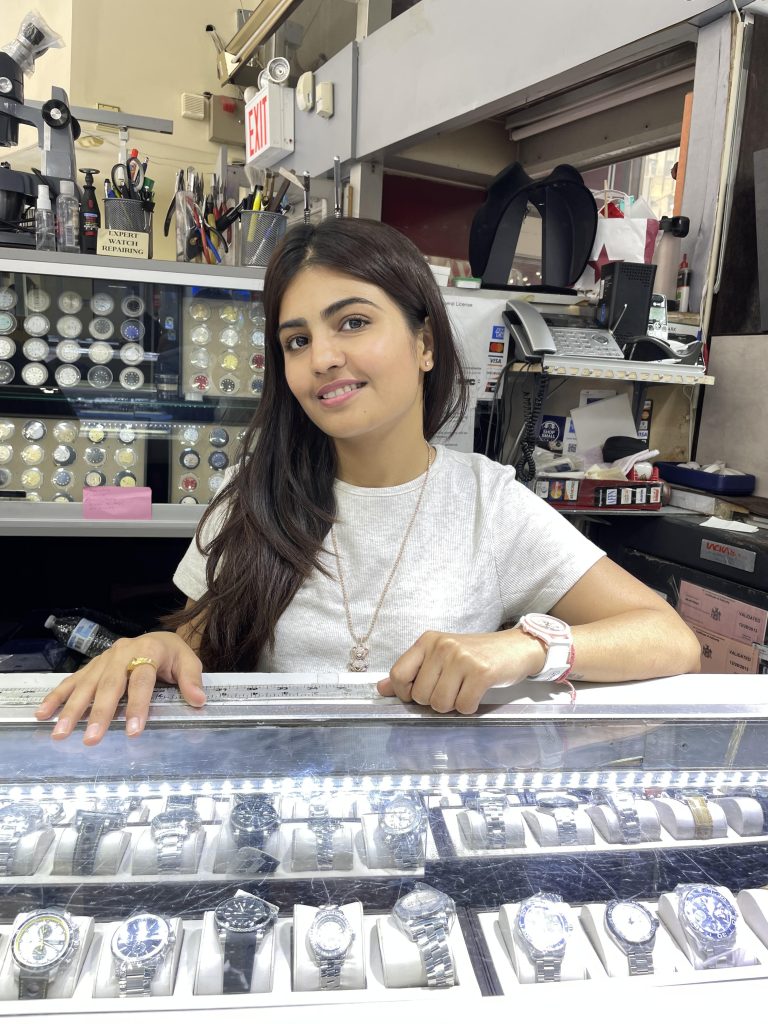
Chevli is originally from Surat but grew up in Mumbai. She started working for a company when she was in school.
“I worked for that company for 10 years. I started in 2010. I’m 25 now. I was doing accounting, then became the company manager. Afterwards, I handled the full company and I had 265 persons working for me. Then I realized this is not for me. I just changed the country and came here. Now I’m so happy,” Chevli said, with an air of nonchalance.
She’s not sure though that she will stick with the diamond industry. She explained one of her personal challenges that she finds hard to fathom.
“I don’t know if I will continue with this. I want to be a successful businesswoman. Till now whoever I met they needed appointments with me. Now, I’m looking to get appointments with people. So, I’m not into this,” she said, with a shrug of her shoulders.
Asked what was important for a woman to succeed in the diamond business, she said: “Just confidence. If you have confidence, then you don’t need even the capital. You are the capital.”
So, is the market not congested?
“It is congested but you still have to jump,” responded Chevli, whose father has supported financially her business dreams.
While there are not too many women like Chevli in the Diamond District, there are plenty of women workers in jewelry stores in Manhattan, including in Macy’s, which under its roof has several big-name brands like De Beers.
A manager for De Beers in Macy’s didn’t take questions on business located there, as she was not allowed to speak to the press. At the time I visited, the section was empty; there were not even customers taking inquisitive peeks at the exquisite jewelry on display.
A woman of Asian origin, working for another jewelry company within Macy’s, speaking on condition of anonymity, indicated that since the end of last year, business for small size diamonds was good.

“Before the pandemic people bought a lot. They didn’t care about money. After the pandemic, in the last six months especially, tourists are coming a lot. At Christmas we did a lot of business. Our target was fulfilled. Now people are coming again. We have good sales on jewelry starting from $50 to $50,000. Mostly couples buy it,” she said.
“Some prefer buying it in the Diamond District, but it’s hard to tell if you are getting a good deal there. Here, they are assured that it’s 100% genuine. And we give a certificate even for a $50 diamond,” she said.
There are other challenges for the Diamond District, including shrinking space.
The New York Times reported recently that a mega-developer has demolished more than a dozen buildings in the Diamond District to make way for a supertall tower and a luxury hotel. According to the Times, some old-school jewelers fear this will change the unique character of the district.
Outsourcing too is taking a toll on the number of workers engaged in the industry. The jewelry industry in the US, while posting better revenue in the last two years, and with projections to grow in the coming decade, has seen the number of workers dwindling in recent years, however. According to IBIS World, there are 136,828 people employed in the jewelry stores industry in the US as of 2023. The number of people employed in the industry in the US declined 2.3% on average over the five years between 2018 and 2023.
Amish Shah, a businessman who deals with lab grown diamonds, and whose office is in the Diamond District, wrote in Forbes: “I am the third generation in my family to work in the diamond business, and my grandfather left me with this piece of advice: ‘Keep looking forward.’ He encouraged me to lead change so that in the future, I can one day pass a thriving business on to the next generation. That’s the only way a legacy continues. During the pandemic, I’ve heard people say, ‘Don’t bet against New York.’ I agree. But to that, I would also add, never bet against 47th Street. We will be back, better than ever.”
India is aiming to become a major player in the lab-grown diamond business. The Indian government recently abolished a 5% tax on imported diamond seeds and announced funding to develop domestic diamond seed production. India currently produces around three million lab-grown diamonds annually, accounting for 15% of global production, according to a report by the Diamond District. Most lab-grown diamonds produced in India are exported to the US. The US also holds 48% of the world’s polished diamond demand, up from the 42% demand it held in 2014.
UNOFFICIAL ‘GOLD DISTRICT’
I traveled by subway to Jackson Heights, Queens, where a street, the Kalpana Chawla Way, is the unofficial ‘Gold District’, especially for South Asian-origin customers. At least 16 glittering jewelry stores line the street, apart from the grocery store Patel Brothers, and clothing and fashion stores, selling also a mishmash of other products. Adding to the salmagundi are street vendors who sell a medley of what pass as jewelry products ranging from $5 upwards.
Some jewelers and staff personnel in Jackson Heights, who spoke on the record, said that unlike the diamond trade, they have had a slower recovery from the pandemic as their business is centered in gold products.
Vaishali Patel, manager for seven years at Sona Mandi, a jewelry store owned by Kamal Kumar, on the Kalpana Chawla Way, said that the business has only rebounded this year, after the shock of the pandemic.

“It rebounded only this year, not in 2021 like in the Diamond District,” she said in an interview. “During the pandemic people saved money to spend on family and food, not on gold. Business was slow but it was not completely a shutdown for us. Now it has rebounded like 2019.
“But we are now worried about 2023, as there is talk of recession. We have six employees and managed to retain all of them during the pandemic. But these are again uncertain times,” Patel said.
She said that a lot of customers also bought gold from the US to take to India, as they felt it was purer and the designs were more attractive and eye catching.
On the same block, Sunita Kanwar is partner with Shiv Dass, of Shri Krishna Jewelers. Dass is also the President of the Jackson Heights Merchants’ Association, and one of the key people to have made the iconic area famous the world over as a Little India hub spot.
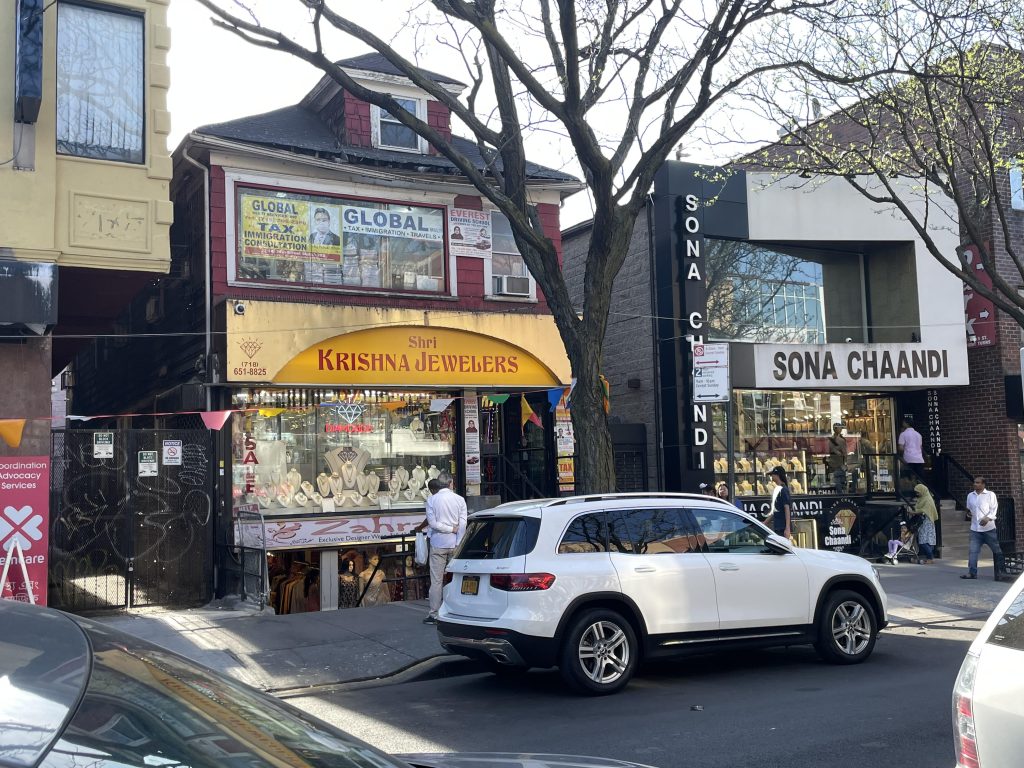
“We have been here since 1986. Indian people don’t care about recession; they will always buy gold as there are always ceremonies,” Kanwar said. “During the pandemic, business was down 100%. We lost workers, people who made the jewelry. If for example there were 100 factories now there are 30 factories. We are still rebounding,” she said.
Asked if there was a lesson learned from the erstwhile Covid pandemic, Kanwar retorted: “Free money is good for everybody.”
(Sujeet Rajan is Editor-in-Chief of www.indiaoverseasreport.com Follow him on Twitter @SujeetRajan1)
(This story was produced as part of the Small Business Reporting Fellowship, organized by the Center for Community Media and funded by the NYC Mayor’s Office of Media and Entertainment.)

